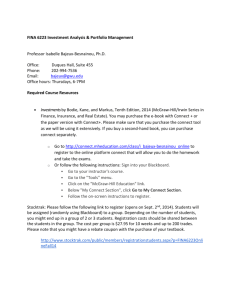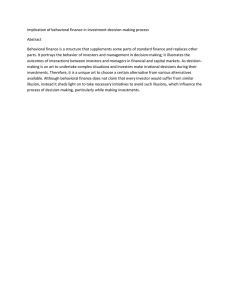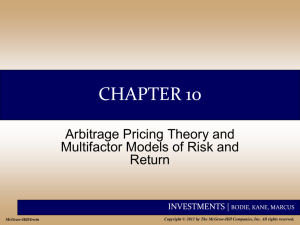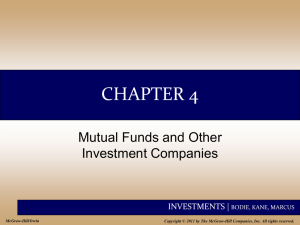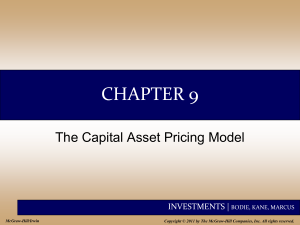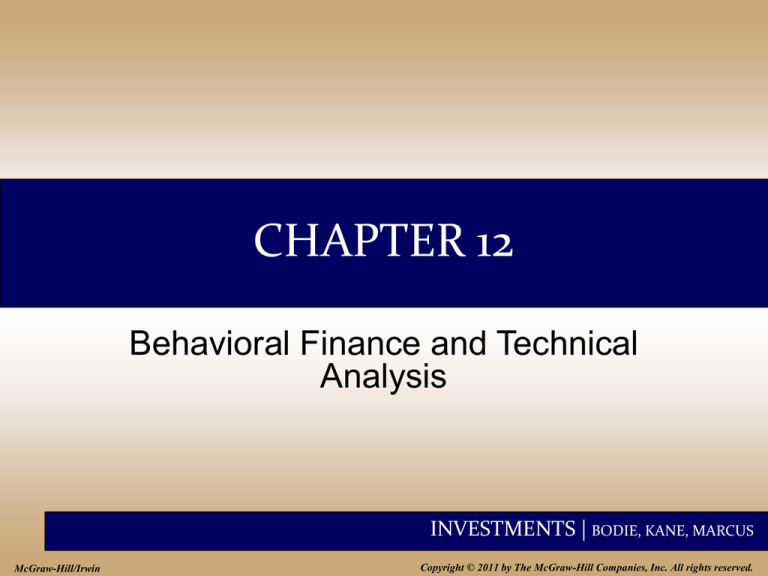
CHAPTER 12
Behavioral Finance and Technical
Analysis
INVESTMENTS | BODIE, KANE, MARCUS
McGraw-Hill/Irwin
Copyright © 2011 by The McGraw-Hill Companies, Inc. All rights reserved.
12-2
Behavioral Finance
Conventional
Finance
• Prices are correct;
equal to intrinsic
value.
• Resources are
allocated efficiently.
• Consistent with EMH
Behavioral Finance
• What if investors don’t
behave rationally?
INVESTMENTS | BODIE, KANE, MARCUS
12-3
The Behavioral Critique
Two categories of irrationalities:
1. Investors do not always process
information correctly.
• Result: Incorrect probability
distributions of future returns.
2. Even when given a probability distribution
of returns, investors may make
inconsistent or suboptimal decisions.
• Result: They have behavioral biases.
INVESTMENTS | BODIE, KANE, MARCUS
12-4
Errors in Information Processing:
Misestimating True Probabilities
1. Forecasting Errors:
Too much weight is
placed on recent
experiences.
3. Conservatism: Investors
are slow to update their
beliefs and under react
to new information.
2. Overconfidence:
Investors
overestimate their
abilities and the
precision of their
forecasts.
4. Sample Size Neglect
and
Representativeness:
Investors are too quick
to infer a pattern or
trend from a small
sample.
INVESTMENTS | BODIE, KANE, MARCUS
12-5
Behavioral Biases
• Biases result in less than rational
decisions, even with perfect
information.
Examples:
1.Framing:
– How the risk is described, “risky losses”
vs. “risky gains”, can affect investor
decisions.
INVESTMENTS | BODIE, KANE, MARCUS
12-6
Behavioral Biases
2. Mental Accounting:
• Investors may segregate accounts or
monies and take risks with their gains
that they would not take with their
principal.
3. Regret Avoidance:
• Investors blame themselves more when
an unconventional or risky bet turns out
badly.
INVESTMENTS | BODIE, KANE, MARCUS
12-7
Behavioral Biases
4. Prospect Theory:
– Conventional view: Utility depends on level of
wealth.
– Behavioral view: Utility depends on changes
in current wealth.
INVESTMENTS | BODIE, KANE, MARCUS
12-8
Figure 12.1 Prospect Theory
INVESTMENTS | BODIE, KANE, MARCUS
12-9
Limits to Arbitrage
• Behavioral biases would not matter
if rational arbitrageurs could fully
exploit the mistakes of behavioral
investors.
• Fundamental Risk:
– “Markets can remain irrational longer
than you can remain solvent.”
– Intrinsic value and market value may
take too long to converge.
INVESTMENTS | BODIE, KANE, MARCUS
12-10
Limits to Arbitrage
• Implementation Costs:
– Transactions costs and restrictions on short
selling can limit arbitrage activity.
• Model Risk:
– What if you have a bad model and the market
value is actually correct?
INVESTMENTS | BODIE, KANE, MARCUS
12-11
Limits to Arbitrage and the
Law of One Price
• Siamese Twin Companies
–Royal Dutch should sell for 1.5
times Shell
–Have deviated from parity ratio
for extended periods
–Example of fundamental risk
INVESTMENTS | BODIE, KANE, MARCUS
12-12
Figure 12.2 Pricing of Royal Dutch Relative
to Shell (Deviation from Parity)
INVESTMENTS | BODIE, KANE, MARCUS
12-13
Limits to Arbitrage and the
Law of One Price
• Equity Carve-outs
– 3Com and Palm
– Arbitrage limited by availability of shares for
shorting
• Closed-End Funds
– May sell at premium or discount to NAV
– Can also be explained by rational return
expectations
INVESTMENTS | BODIE, KANE, MARCUS
12-14
Bubbles and Behavioral Economics
• Bubbles are easier to spot after
they end.
– Dot-com bubble
– Housing bubble
INVESTMENTS | BODIE, KANE, MARCUS
12-15
Bubbles and Behavioral Economics
• Rational explanation for
stock market bubble
using the dividend
discount model:
D1
PV0
kg
• S&P 500 is worth
$12,883 million if
dividend growth rate is
8% (close to actual
value in 2000).
• S&P 500 is worth
$8,589 million if
dividend growth rate is
7.4% (close to actual
value in 2002).
INVESTMENTS | BODIE, KANE, MARCUS
12-16
Technical Analysis and Behavioral
Finance
• Technical analysis attempts to exploit
recurring and predictable patterns in stock
prices.
– Prices adjust gradually to a new equilibrium.
– Market values and intrinsic values converge
slowly.
INVESTMENTS | BODIE, KANE, MARCUS
12-17
Technical Analysis and Behavioral
Finance
• Disposition effect: The tendency of
investors to hold on to losing investments.
– Demand for shares depends on price history
– Can lead to momentum in stock prices
INVESTMENTS | BODIE, KANE, MARCUS
12-18
Trends and Corrections:
The Search for Momentum
Dow Theory
1. Primary trend : Long-term movement of
prices, lasting from several months to
several years.
2. Secondary or intermediate trend: shortterm deviations of prices from the
underlying trend line and are eliminated by
corrections.
3. Tertiary or minor trends: Daily fluctuations
of little importance.
INVESTMENTS | BODIE, KANE, MARCUS
12-19
Figure 12.3 Dow Theory Trends
INVESTMENTS | BODIE, KANE, MARCUS
12-20
Trends and Corrections: Moving
Averages
• The moving average
is the average level of
prices over a given
interval of time.
• Bullish signal: Market
price breaks through
the moving average
line from below. Time
to buy
• Bearish signal: When
prices fall below the
moving average, it is
time to sell.
INVESTMENTS | BODIE, KANE, MARCUS
12-21
Figure 12.5 Moving Average for HPQ
INVESTMENTS | BODIE, KANE, MARCUS
12-22
Trends and Corrections: Breadth
Breadth: Often
measured as the
spread between
the number of
stocks that
advance and
decline in price.
INVESTMENTS | BODIE, KANE, MARCUS
12-23
Sentiment Indicators:
Trin Statistic
• Trin Statistic:
volume.declining
trin
number.declining
volume.advancing
number.advancing
Ratios above 1.0 are bearish
INVESTMENTS | BODIE, KANE, MARCUS
12-24
Sentiment Indicators:
Confidence Index
• Confidence index:
The ratio of the
average yield on 10
top-rated corporate
bonds divided by the
average yield on 10
intermediate-grade
corporate bonds.
• Higher values are
bullish.
INVESTMENTS | BODIE, KANE, MARCUS
12-25
Sentiment Indicators:
Put/Call Ratio
• Calls are the right to
buy.
– A way to bet on rising
prices
• Puts are the right to
sell.
– A way to bet on falling
prices
• A rising ratio may
signal investor
pessimism and a
coming market
decline.
• Contrarian investors
see a rising ratio as a
buying opportunity!
INVESTMENTS | BODIE, KANE, MARCUS
12-26
Warning!
• It is possible to perceive patterns that really
don’t exist.
• Figure 12.8A is based on the real data. The
graph in panel B was generated using
“returns” created by a random-number
generator.
• Figure 12.9 shows obvious randomness in
the weekly price changes behind the two
panels in Figure 12.8
INVESTMENTS | BODIE, KANE, MARCUS
12-27
Figure 12.8 Actual and Simulated Levels for
Stock Market Prices of 52 Weeks
INVESTMENTS | BODIE, KANE, MARCUS
12-28
Figure 12.9 Actual and Simulated Changes
in Stock Prices for 52 Weeks
INVESTMENTS | BODIE, KANE, MARCUS

